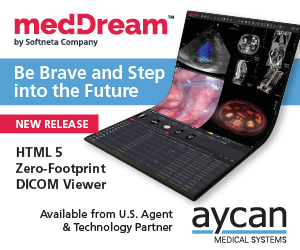|
E-Newsletter • March 2023 |
▼ ADVERTISEMENT

Editor's E-Note
Ultrasound has many advantages, such as being a less expensive test and not using ionizing radiation, but it has drawbacks, as well. Researchers in the United Kingdom have found a solution for one of those drawbacks by developing a method that allows clinicians to measure the level of tension in human tissue, which is an indicator of disease. Even better, the method requires no prior knowledge of the tissue's condition. This month's newsletter has the details.
How many ultrasound units does your facility have? Let us know on Twitter and/or Facebook.
Enjoy the newsletter.
— Dave Yeager, editor |
|
|
| In This E-Newsletter
|
▼ ADVERTISEMENT
 |
|
|
New Ultrasound Method Could Lead to Easier Disease Diagnosis
A new ultrasound method that can measure the level of tension in human tissue for the first time—a key indicator of disease—has been developed by researchers from the University of Sheffield.
The breakthrough, made by Artur Gower from the university’s Department of Mechanical Engineering, together with researchers from Harvard, Tsinghua University, and the University of Galway, could be used to build new ultrasound machines that are able to better diagnose abnormal tissue, scarring, and cancer.
Ultrasounds use sound waves to create images of organs inside the human body. However, the images produced by the current techniques used in health care aren’t usually enough to diagnose whether tissues are abnormal. To improve diagnosis, the researchers developed a way to measure forces such as tension by using an ultrasound machine. Tension is generated in all living tissue, so measuring it can indicate whether tissue is functioning properly or affected by disease.
▼ ADVERTISEMENT
 |
AI Image Generation Could Be the Future of Radiology
A paper published in the Journal of Medical Internet Research shows promising findings for an emerging text-to-image AI tool. The tool can augment, manipulate, and generate images that could be helpful to radiologists and the wider health care field.
IR Procedures Taking Over Pain Management
Interventional radiologists are finding new, noninvasive ways to treat common chronic pain, such as low back pain, osteoarthritis knee pain, and benign prostatic hypertrophy. Findings presented at the Society of Interventional Radiology annual meeting show positive and promising results.
Radiologic Intervention Could Prevent Diagnostic Ureteroscopy
A new study shows that catching upper tract urothelial carcinoma early could prevent patients from receiving a diagnostic ureteroscopy which could fast track them to early treatment. |
“The minimally invasive innovations Dr Matthew Taon and the BAMC interventional radiology team perform are just another example of the cutting-edge medical capabilities of the San Antonio market. This intervention greatly contributes to returning our soldiers and airmen to the fight, improving our service member's readiness and ability to serve our nation anytime and anywhere we are called.”
— COL Michael Wirt, MD, PhD, chief of the department of radiology at Brooke Army Medical Center, on a nonsurgical injectable procedure used to repair disc degeneration |
|
|
COVER STORY
Multiple Realities
Augmented and virtual reality technology is making diagnostic decisions easier for clinicians.
FEATURE
Incidental Contact
Incidental findings pose a challenge for health care providers. Making sure radiologists’ findings are communicated to referring physicians and followed up in a timely manner has significant implications for patient outcomes.
|
|
|
| Advertising Opportunities |
Have a product or service you want to market to radiology professionals? Utilize the reach of Radiology Today Magazine to accomplish your marketing goals. Email our experienced account executives today at sales@gvpub.com or call 800-278-4400 for more information.
|
| © 2023 Radiology Today Magazine |
|
|